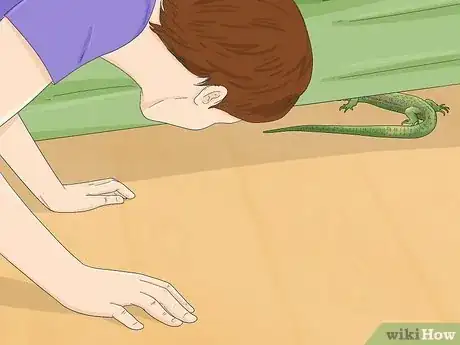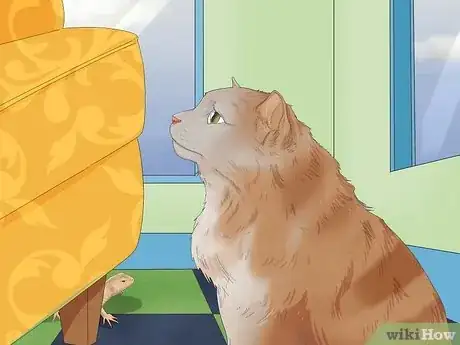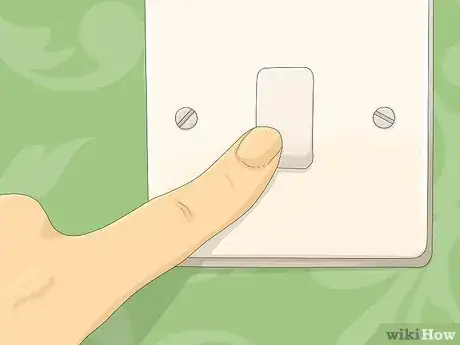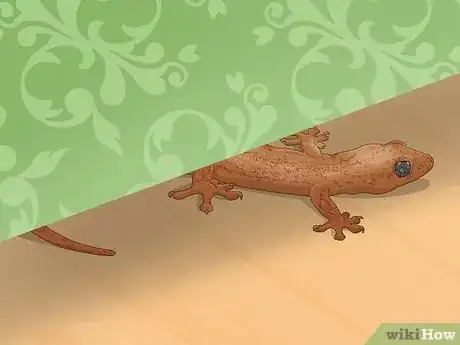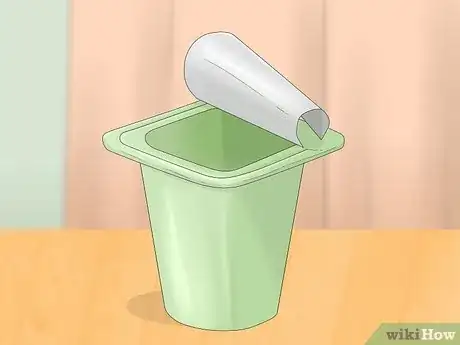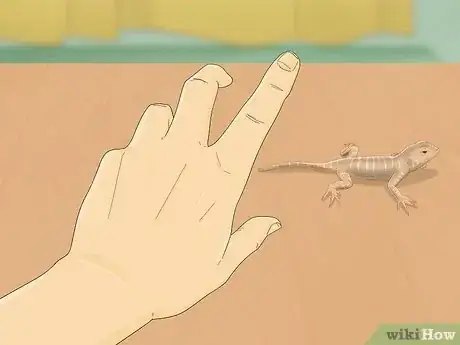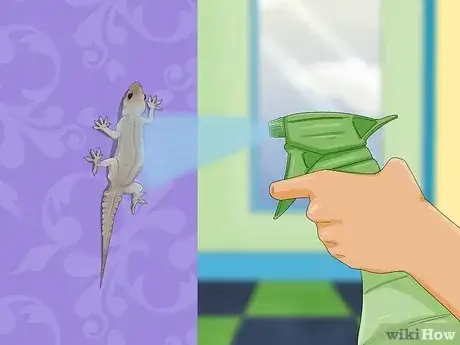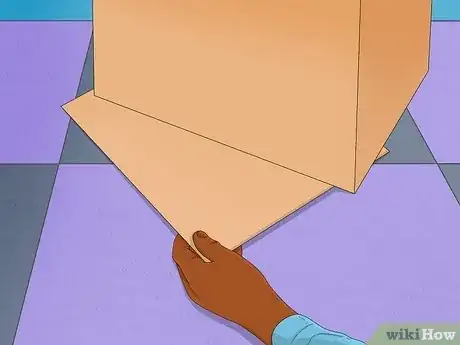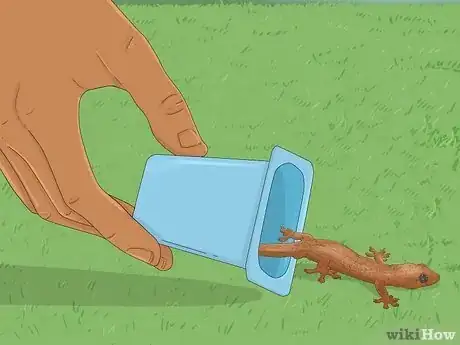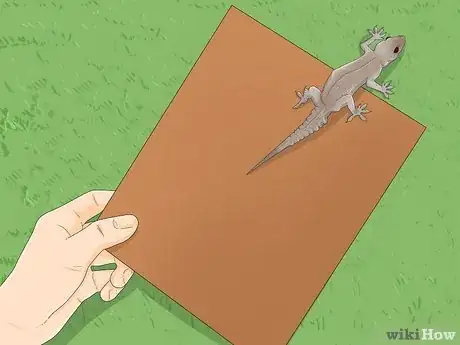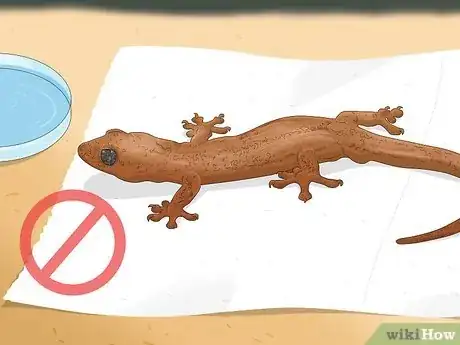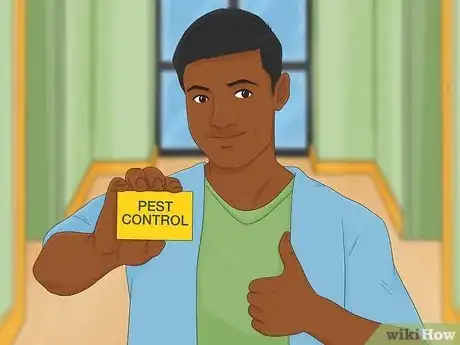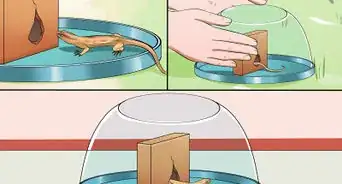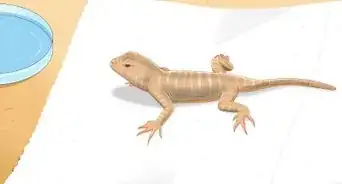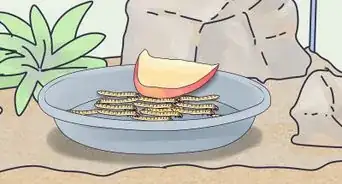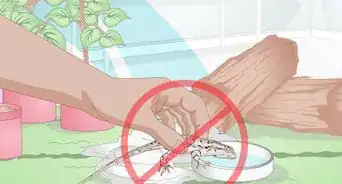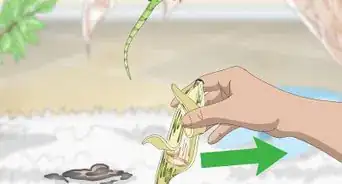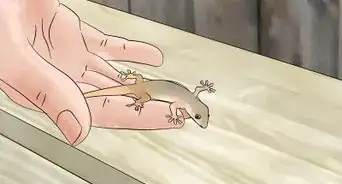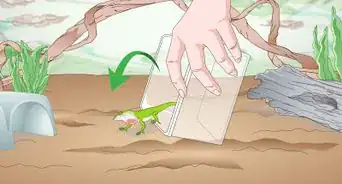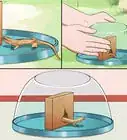This article was co-authored by Scott McCombe and by wikiHow staff writer, Devin McSween. Scott McCombe is the CEO of Summit Environmental Solutions (SES), a family-owned local pest solutions, animal control, and home insulation company based in Northern Virginia. Founded in 1991, SES has an A+ rating with the Better Business Bureau and has been awarded “Top Rated Professional,” and “Elite Service Award" by HomeAdvisor.
There are 14 references cited in this article, which can be found at the bottom of the page.
This article has been viewed 282,135 times.
You hear a rustling and whip around to see a blur of green running across your floor. A lizard is loose and hiding somewhere in your home, so how can you catch it? Whether you’re looking for a lost pet or have an unwelcome guest in your house, we’ll show you how to find and safely capture a lizard. If you’re dealing with a wild lizard, we’ll also tell you how to release them back outside. Read on to learn how!
Things You Should Know
- Close all your doors and windows, shut off the lights, and look for the lizard in dark, enclosed spaces.
- Lure the lizard out by setting a humane trap baited with bugs and fruit. Or, repel them from your home by placing eggshells or mothballs around your house.
- Catch the lizard by slowly approaching them and coaxing them into a small container. Then, place a piece of paper over the container.
- If the lizard is wild, release them outdoors about 1 yard (1m) away from your house.
Steps
Finding the Lizard
-
1Close off the room where you last saw the lizard. Shut all the doors and windows in the room so the lizard cannot escape. Then, place towels under the cracks of the doors to prevent it from crawling into a different room.[1]
- If you think the lizard escaped to a different room, check places in your house that are dark and warm. Inside kitchen and laundry cupboards or behind appliances and blinds are common lizard hiding places.
-
2Check dark, enclosed spaces to see if the lizard is hiding there. Lizards often enjoy hanging out in small or covered spaces. Look under any couches, chairs, desks, bookshelves, or tables in the room. Closets, vents, baseboards, cushions, and potted plants are also popular places for lizards to hide.[2]
- Use a flashlight to help you see into dark spaces.
- Lizards like hiding behind hanging items too, so check behind any frames and mirrors on the wall.
Advertisement -
3Keep your pets in a different room. Most lizards are pretty skittish, so they’ll run and hide from large animals like cats and dogs. If your pets are in the room, get them to stay in a different room until you have caught the lizard.[3]
- If a wild lizard is in your home and you have a cat, they can help catch the lizard. Just know that your cat will think the lizard is prey and likely kill it.
-
4Turn off all of the lights in the room. Many lizards are more active at night, so they might come out of their hiding space if they think it is dark outside. Close any blinds or curtains to block out the sun. Then, turn off all the lights. Keep your flashlight at the ready and listen for any rustling noises that mean the lizard is on the move.[4]
-
5Wait around 30 minutes for the lizard to come out of hiding. The lizard will only come out of their hiding place when they feel safe. Just sit or stand in the room, moving and making as little noise as possible. After about 30 minutes, the lizard usually feels comfortable enough to move out into the open.[5]
- Alternatively, set a trap to lure the lizard out of hiding. Place plastic wrap over a small box and cut a slit. Or, use a humane cage or mouse trap for larger lizards. Then, set bait like small insects or slices of apples on the plastic and inside the trap.[6]
- If you don’t have time to wait for the lizard to move, repel the lizard from your home. Most lizards don’t like the smell of eggshells, mothballs, and garlic, so place these items under your furniture, appliances, and near doorways to draw them out.
Capturing the Lizard
-
1Find a container to catch the lizard in. Using a container is a great way to catch a lizard without using your hands. Luckily, most house lizards are only about 2–3 inches (5.1–7.6 cm) long. So, old food packages like an empty margarine container or a large yogurt cup are ideal for catching one.[7]
- If you’re not sure how large the lizard is, a shoe box or small cardboard box is likely big enough to catch it.
- If you’re dealing with a large lizard, call your local pest control service. They’ll have the tools to capture the lizard and identify if it’s potentially someone’s lost pet.
-
2Approach the lizard slowly. If you startle the lizard, they will likely run back into their hiding spot. Instead, walk towards the lizard very slowly. If the lizard starts to move, stop and stay still for a second until they calm down.[8]
-
3Chase the lizard into the container. If the lizard is on the floor, turn your container sideways and gently place it on the ground near the lizard. Then, use a broom handle or yardstick to coax them towards the box. In most cases, the lizard will run into the container, as they will think that the container is safe.[9]
- If the lizard is on the wall, hold the box under or to the side of the lizard. Then use a magazine or piece of paper to drive the lizard into the box.
- Do not touch the lizard with the broom or yardstick. Simply move it towards the lizard to encourage them to run towards the box.
- Protect yourself and the lizard by not using your hand to grab or chase them. Most lizards are scared easily, which can cause their tails to fall off. When threatened, the lizard might even try to bite you.
-
4Spray the lizard with cold water if they keep running away. If the lizard won’t go into the box, spray or flick them with cold water. Cold water can cause the lizard to slow down or even freeze for a minute or two. This is your opportunity to gently place your container over the lizard.[10]
-
5Slide a piece of cardboard or paper under the container. Once the lizard is in the box, trap them inside. Slip a piece of paper or cardboard over the opening of the container, completely covering it. Keep the piece of paper there until you’re ready to release the wild lizard outside or return your pet lizard to their cage.[11]
Releasing a Wild Lizard
-
1Take the lizard outside and away from your house. Wild lizards belong in the great outdoors, so take them back outside to release them. Just step about 1 yard (1 m) away from your house. Don’t release the lizard too close to your house, as they have a better chance of running straight back inside.[12]
-
2Remove the paper from the container. Hold the container close to the ground and remove the cardboard or paper. The lizard should scamper right out. If they don’t immediately leave, set the container sideways on the ground and step away for a few minutes. The lizard may be too scared and only leave when you are gone.[13]
- Alternatively, gently tip the lizard out of the container while holding it close to the ground.
-
3Do not keep a wild lizard as a pet. You might find your new lizard friend cute, but release them back outside. Most wild lizards will not thrive if they’re kept in cages or aquariums as pets. These are wild animals that need to hunt and roam outdoors with other lizards.[14]
-
4Call pest control if you believe you have a lizard infestation. If you’re finding lots of lizards in your home, get help from a pest control service. They will examine your home for any entryways that lizards are using to enter your home and capture or eliminate the lizard population inside.[15]
- Prevent lizards from entering your home by covering up cracks and gaps around your doors and windows. Install weatherstripping to seal entryways, or use caulk or spray foam to fix gaps along your walls.
- A pest control service will also help you if you have a large lizard loose in your home.
Warnings
- Always approach lizards slowly and cautiously; do not grab them directly. Even pet lizards can bite if they feel cornered or threatened. While most lizards are not venomous, this bite can still hurt.⧼thumbs_response⧽
- Do not grab a lizard by their tail as that can cause it to fall off.⧼thumbs_response⧽
References
- ↑ http://www.anapsid.org/iguana/lostigs.html
- ↑ http://www.reptileexpert.co.uk/whatifreptileescapes.html
- ↑ http://pestkilled.com/how-to-get-rid-of-geckos/
- ↑ http://www.reptileexpert.co.uk/whatifreptileescapes.html
- ↑ http://www.reptileexpert.co.uk/whatifreptileescapes.html
- ↑ https://edis.ifas.ufl.edu/publication/IN528
- ↑ http://citybugs.tamu.edu/factsheets/household/misc-house/ent-2006/
- ↑ https://citybugs.tamu.edu/factsheets/household/misc-house/ent-2006/
- ↑ https://ipm.ucanr.edu/home-and-landscape/lizards/pest-notes/?src=302-www&fr=3779
- ↑ https://pestkilled.com/how-to-get-rid-of-geckos/
- ↑ http://www.sdnhm.org/science/herpetology/resources/faqs-on-reptiles-and-amphibians/
- ↑ http://citybugs.tamu.edu/factsheets/household/misc-house/ent-2006/
- ↑ https://ipm.ucanr.edu/home-and-landscape/lizards/pest-notes/?src=302-www&fr=3779
- ↑ https://www.wildlifeillinois.org/gallery/amphibians-and-reptiles/lizards/
- ↑ http://pestkilled.com/how-to-get-rid-of-geckos/
- ↑ Scott McCombe. Pest Control Specialist. Expert Interview. 19 November 2019.
- ↑ http://citybugs.tamu.edu/factsheets/household/misc-house/ent-2006/
About This Article
If you have a lizard in your house and you need to catch it, close the windows and doors in the room where you last saw the lizard, and keep other pets out of the area. Use a flashlight to check dark, enclosed spaces, like under couches, chairs, or the bed. If you can’t find it, turn off all the lights in the room and wait for about 30 minutes, then check again. Once you do find the lizard, approach it very slowly, then place a box or container face-down over the lizard. Slide a piece of cardboard or paper under the box, then carefully pick it up and move the lizard. For tips on how to safely release a wild lizard, read on!

